Detecting the Dominant Cause of Streamflow Decline in the Loess Plateau of China Based onthe Latest Budyko Equation
Abstract
1. Introduction
2. Study Area and Data
2.1. Overview of the Wei River Basin
2.2. Study Data
3. Methodology
3.1. Breakpoints Analysis
3.2. Quantifying the Influences of Climate Change and Human Activities on Streamflow Change
3.2.1. Budyko Framework
3.2.2. Decomposition Method
3.2.3. Climate Elasticity Method
3.3. Impacts of Direct Human Activities on Streamflow
4. Results
4.1. Change Points Analysis
4.2. Climatic Aridity Index and Elasticity of Runoff
4.3. Quantitative Attribution of Streamflow Decrease
5. Discussion
6. Conclusions
Author Contributions
Funding
Acknowledgments
Conflicts of Interest
References
- Huntington, T.G. Evidence for intensification of the global water cycle: Review and synthesis. J. Hydrol. 2006, 319, 83–95. [Google Scholar] [CrossRef]
- Milly, P.C.; Dunne, K.A.; Vecchia, A.V. Global pattern of trends in streamflow and water availability in a changing climate. Nature 2005, 438, 347–350. [Google Scholar] [CrossRef] [PubMed]
- Gao, Y.; Zhu, X.; Yu, G.; He, N.; Wang, Q.; Tian, J. Water use efficiency threshold for terrestrial ecosystem carbon sequestration in China under afforestation. Agric. For. Meteorol. 2014, 195, 32–37. [Google Scholar] [CrossRef]
- Mccabe, G.J.; Wolock, D.M. A step increase in streamflow in the conterminous United States. Geophys. Res. Lett. 2002, 29, 38-1–38-4. [Google Scholar] [CrossRef]
- Birsan, M.V.; Molnar, P.; Burlando, P.; Pfaundler, M. Streamflow trends in Switzerland. J. Hydrol. 2005, 314, 312–329. [Google Scholar] [CrossRef]
- Khaliq, M.N.; Ouarda, T.B.M.J.; Gachon, P. Identification of temporal trends in annual and seasonal low flows occurring in Canadian rivers: The effect of short- and long-term persistence. J. Hydrol. 2009, 369, 183–197. [Google Scholar] [CrossRef]
- Velpuri, N.M.; Senay, G.B. Analysis of long-term trends (1950–2009) in precipitation, runoff and runoff coefficient in major urban watersheds in the United States. Environ. Res. Lett. 2013, 8, 24020–24026. [Google Scholar] [CrossRef]
- Vörösmarty, C.J.; Green, P.; Salisbury, J.; Lammers, R.B. Global Water Resources: Vulnerability from Climate Change and Population Growth. Science 2000, 289, 284–288. [Google Scholar] [CrossRef] [PubMed]
- Patterson, L.A.; Lutz, B.; Doyle, M.W. Climate and direct human contributions to changes in mean annual streamflow in the South Atlantic, USA. Water Resour. Res. 2013, 49, 7278–7291. [Google Scholar] [CrossRef]
- Berghuijs, W.R.; Woods, R.A.; Hrachowitz, M. A precipitation shift from snow towards rain leads to a decrease in streamflow. Nat. Clim. Chang. 2014, 4, 583–586. [Google Scholar] [CrossRef]
- Pachauri, R.K.; Allen, M.R.; Barros, V.R.; Broome, J.; Cramer, W.; Christ, R.; Church, J.A.; Clarke, L.; Dahe, Q.; DASGUPTA, P.; et al. Climate Change 2014: Synthesis Report; Contribution of Working Groups I, II and III to the Fifth Assessment Report of the Intergovernmental Panel on Climate Change; IPCC: Geneva, Switzerland, 2014; p. 151. [Google Scholar]
- Déry, S.J.; Hernández-Henríquez, M.A.; Burford, J.E.; Wood, E.F. Observational evidence of an intensifying hydrological cycle in northern Canada. Geophys. Res. Lett. 2009, 36, 88–97. [Google Scholar] [CrossRef]
- Thompson, J.R. Modelling the impacts of climate change on upland catchments in southwest Scotland using MIKE SHE and the UKCP09 probabilistic projections. Hydrol. Res. 2012, 43, 507. [Google Scholar] [CrossRef]
- Xiong, L.; Yu, K.; Zhang, H.; Zhang, L. Annual runoff change in the headstream of Yangtze River and its relation to precipitation and air temperature. Hydrol. Res. 2013, 44, 850–874. [Google Scholar] [CrossRef]
- Cruise, J.F.; Laymon, C.A.; Al-Hamdan, O.Z. Impact of 20 Years of Land-Cover Change on the Hydrology of Streams in the Southeastern United States 1. J. Am. Water Resour. Assoc. 2010, 46, 1159–1170. [Google Scholar] [CrossRef]
- Zheng, J.; Yu, X.; Deng, W.; Wang, H.; Wang, Y. Sensitivity of Land-Use Change to Streamflow in Chaobai River Basin. J. Hydrol. Eng. 2013, 18, 457–464. [Google Scholar] [CrossRef]
- Rossi, A.; Massei, N.; Laignel, B.; Sebag, D.; Copard, Y. The response of the Mississippi River to climate fluctuations and reservoir construction as indicated by wavelet analysis of streamflow and suspended-sediment load, 1950–1975. J. Hydrol. 2009, 377, 237–244. [Google Scholar] [CrossRef]
- Weiskel, P.K.; Vogel, R.M.; Steeves, P.A.; Zarriello, P.J.; DeSimone, L.A.; Ries, K.G. Water use regimes: Characterizing direct human interaction with hydrologic systems. Water Resour. Res. 2007, 43. [Google Scholar] [CrossRef]
- Huang, S.; Huang, Q.; Chang, J.; Leng, G. Linkages between hydrological drought, climate indices and human activities: A case study in the Columbia River basin. Int. J. Climatol. 2016, 36, 280–290. [Google Scholar] [CrossRef]
- Xu, X.; Yang, D.; Yang, H.; Lei, H. Attribution analysis based on the Budyko hypothesis for detecting the dominant cause of runoff decline in Haihe basin. J. Hydrol. 2014, 510, 530–540. [Google Scholar] [CrossRef]
- Wu, J.; Miao, C.; Wang, Y.; Duan, Q.; Zhang, X. Contribution analysis of the long-term changes in seasonal runoff on the Loess Plateau, China, using eight Budyko-based methods. J. Hydrol. 2016, 545, 263–275. [Google Scholar] [CrossRef]
- Wang, D.; Hejazi, M. Quantifying the relative contribution of the climate and direct human impacts on mean annual streamflow in the contiguous United States. Water Resour. Res. 2011, 47, 411. [Google Scholar] [CrossRef]
- Wang, X. Advances in separating effects of climate variability and human activity on stream discharge: An overview. Adv. Water Resour. 2014, 71, 209–218. [Google Scholar] [CrossRef]
- Gao, G.; Fu, B.; Wang, S.; Liang, W.; Jiang, X. Determining the hydrological responses to climate variability and land use/cover change in the Loess Plateau with the Budyko framework. Sci. Total Environ. 2016, 557, 331–342. [Google Scholar] [CrossRef] [PubMed]
- Arnell, N.W. Climate change and global water resources. Glob. Environ. Chang. 1999, 9, S31–S49. [Google Scholar] [CrossRef]
- Pahl-Wostl, C.; Knieper, C. The capacity of water governance to deal with the climate change adaptation challenge: Using fuzzy set Qualitative Comparative Analysis to distinguish between polycentric, fragmented and centralized regimes. Glob. Environ. Chang. 2014, 29, 139–154. [Google Scholar] [CrossRef]
- Fang, W.; Huang, Q.; Huang, S.; Yang, J.; Meng, E.; Li, Y. Optimal sizing of utility-scale photovoltaic power generation complementarily operating with hydropower: A case study of the world’s largest hydro-photovoltaic plant. Energy Convers. Manag. 2017, 136, 161–172. [Google Scholar] [CrossRef]
- Zhang, S.; Yang, D.; Jayawardena, A.W.; Xu, X.; Yang, H. Hydrological change driven by human activities and climate variation and its spatial variability in Huaihe Basin, China. Int. Assoc. Sci. Hydrol. Bull. 2015, 61, 1370–1382. [Google Scholar] [CrossRef]
- Chiew, F.H.S.; Teng, J.; Vaze, J.; Post, D.A.; Perraud, J.M.; Kirono, D.G.C.; Viney, N.R. Estimating climate change impact on runoff across southeast Australia: Method, results, and implications of the modeling method. Water Resour. Res. 2009, 45, 82–90. [Google Scholar] [CrossRef]
- Bao, Z.; Zhang, J.; Wang, G.; Fu, G.; He, R.; Yan, X. Attribution for decreasing streamflow of the Haihe River basin, northern China: Climate variability or human activities? J. Hydrol. 2012, 460, 117–129. [Google Scholar] [CrossRef]
- Fohrer, N.; Haverkamp, S.; Frede, H.G. Assessment of the effects of land use patterns on hydrologic landscape functions: Development of sustainable land use concepts for low mountain range areas. Hydrol. Process. 2005, 19, 659–672. [Google Scholar] [CrossRef]
- Schilling, K.E.; Chan, K.S.; Liu, H.; Zhang, Y.K. Quantifying the effect of land use land cover change on increasing discharge in the Upper Mississippi River. J. Hydrol. 2010, 387, 343–345. [Google Scholar] [CrossRef]
- Bourgault, M.A.; Larocque, M.; Roy, M. Simulation of aquifer-peatland-river interactions under climate change. Hydrol. Res. 2014, 45, 425–440. [Google Scholar] [CrossRef]
- Jiang, T.; Chen, Y.D.; Xu, C.Y.; Chen, X.; Chen, X.; Singh, V.P. Comparison of hydrological impacts of climate change simulated by six hydrological models in the Dongjiang Basin, South China. J. Hydrol. 2007, 336, 316–333. [Google Scholar] [CrossRef]
- Zhang, L.; Zhao, F.F.; Brown, A.E. Predicting effects of plantation expansion on streamflow regime for catchments in Australia. Hydrol. Earth Syst. Sci. Discuss. 2012, 9, 379–403. [Google Scholar] [CrossRef]
- Wei, X.H.; Zhang, M.F. Quantifying streamflow change caused by forest disturbance at a large spatial scale: A single watershed study. Water Resour. Res. 2010, 46, 439–445. [Google Scholar] [CrossRef]
- Baw-Puh, F. On the calculation of the Evaporation from land surface. Chin. J. Atmos. Sci. 1981, 1, 002. [Google Scholar]
- Choudhury, B. Evaluation of an empirical equation for annual evaporation using field observations and results from a biophysical model. J. Hydrol. 1999, 216, 99–110. [Google Scholar] [CrossRef]
- Yang, H.; Yang, D.; Lei, Z.; Sun, F. New analytical derivation of the mean annual water-energy balance equation. Water Resour. Res. 2008, 44, 893–897. [Google Scholar] [CrossRef]
- Zhang, L.; Dawes, W.R.; Walker, G.R. Response of Mean Annual ET to Vegetation Changes at Catchment Scale. Water Resour. Res. 2001, 37, 701–708. [Google Scholar] [CrossRef]
- Wang, D.; Tang, Y. A one-parameter Budyko model for water balance captures emergent behavior in Darwinian hydrologic models. Geophys. Res. Lett. 2014, 41, 4569–4577. [Google Scholar] [CrossRef]
- Xing, W.; Wang, W.; Zou, S.; Deng, C. Projection of future runoff change using climate elasticity method derived from Budyko framework in major basins across China. Glob. Planet. Chang. 2018, 162, 120–135. [Google Scholar] [CrossRef]
- Liang, K.; Liu, C.; Liu, X.; Song, X. Impacts of climate variability and human activity on streamflow decrease in a sediment concentrated region in the Middle Yellow River. Stoch. Environ. Res. Risk Assess. 2013, 27, 1741–1749. [Google Scholar] [CrossRef]
- Sun, Y.; Tian, F.; Yang, L.; Hu, H. Exploring the spatial variability of contributions from climate variation and change in catchment properties to streamflow decrease in a mesoscale basin by three different methods. J. Hydrol. 2014, 508, 170–180. [Google Scholar] [CrossRef]
- Li, Z.; Liu, W.Z.; Zhang, X.C.; Zheng, F.L. Impacts of land use change and climate variability on hydrology in an agricultural catchment on the Loess Plateau of China. J. Hydrol. 2009, 377, 35–42. [Google Scholar] [CrossRef]
- Mu, X.M.; Basang, C.; Zhang, L.; Gao, P.; Wang, F.; Zhang, X.P. Impact of soil conservation measures on runoff and sediment in Hekou-Longmen region of the Yellow River. J. Sediment Res. 2007, 2, 36–41. [Google Scholar]
- Zhan, C.S.; Jiang, S.S.; Sun, F.B.; Jia, Y.W.; Niu, C.W.; Yue, W.F. Quantitative contribution of climate change and human activities to runoff changes in the Wei River basin, China. Hydrol. Earth Syst. Sci. 2014, 11, 2149–2175. [Google Scholar] [CrossRef]
- Huang, S.; Chang, J.; Huang, Q.; Chen, Y. Spatio-temporal changes and frequency analysis of drought in the Wei River Basin, China. Water Resour. Manag. 2014, 28, 3095–3110. [Google Scholar] [CrossRef]
- Huang, S.; Chang, J.; Huang, Q.; Chen, Y. Monthly streamflow prediction using modified EMD-based support vector machine. J. Hydrol. 2014, 511, 764–775. [Google Scholar] [CrossRef]
- Liu, S.; Huang, S.; Xie, Y.; Leng, G.; Huang, Q.; Wang, L.; Xue, Q. Spatial-temporal changes of rainfall erosivity in the loess plateau, China: Changing patterns, causes and implications. CATENA 2018, 166, 279–289. [Google Scholar] [CrossRef]
- Allen, R.G.; Pereira, L.S.; Raes, D.; Smith, M. Crop Evapotranspiration-Guidelines for Computing Crop Water Requirements; FAO Irrigation and Drainage Paper 56; FAO-Food and Agriculture Organisation of the United Nations: Rome, Italy, 1998; Volume 300, pp. 156, 178. [Google Scholar]
- Fang, W.; Huang, S.; Huang, Q.; Huang, G.; Meng, E.; Luan, J. Reference evapotranspiration forecasting based on local meteorological and global climate information screened by partial mutual information. J. Hydrol. 2018, 561, 764–779. [Google Scholar] [CrossRef]
- Monteith, J.L. Evaporation and Environment. Symp. Soc. Exp. Biol. 1965, 19, 205–234. [Google Scholar] [PubMed]
- Thiessen, A.H. Precipitation Averages for Large Areas. Mon. Weather Rev. 1911, 39, 1082–1084. [Google Scholar] [CrossRef]
- Xing-Min, M.U.; Wang, L.I. Review of Evaluation Method of Impact of Soil and Water Conservation Practices on River Flows. Bull. Soil Water Conserv. 2004, 24, 73–78. [Google Scholar]
- Zhao, J.; Huang, Q.; Chang, J.; Liu, D.; Huang, S.; Shi, X. Analysis of temporal and spatial trends of hydro-climatic variables in the Wei River Basin. Environ. Res. 2015, 139, 55–64. [Google Scholar] [CrossRef] [PubMed]
- Yao, W.; Ran, D.; Chen, J. Recent changes in runoff and sediment regimes and future projections in the Yellow River basin. Adv. Water Sci. 2013, 24, 607–616. [Google Scholar]
- Zhao, J. Streamflow and Sediment Discharge Change and Its Response to Climate Change and Human Activities of Wei River Basin. Master’s Thesis, Xi’an University of Technology, Xi’an, China, 2014. [Google Scholar]
- Bernaola-Galván, P.; Ivanov, P.C.; Amaral, L.A.N.; Stanley, H.E. Scale invariance in the nonstationarity of human heart rate. Phys. Rev. Lett. 2001, 87, 168105. [Google Scholar] [CrossRef] [PubMed]
- Budyko, M.I. Climate and Life; Academic: San Diego, CA, USA, 1974. [Google Scholar]
- Malagò, A.; Bouraoui, F.; De Roo, A. Diagnosis and Treatment of the SWAT Hydrological Response Using the Budyko Framework. Sustainability 2018, 10, 1373. [Google Scholar] [CrossRef]
- Horton, R.E. The Rôle of infiltration in the hydrologic cycle. Eos Trans. Am. Geophys. Union 1933, 14, 446–460. [Google Scholar] [CrossRef]
- Troch, P.A.; Martinez, G.F.; Pauwels, V.R.; Durcik, M.; Sivapalan, M.; Harman, C.; Brooks, P.D.; Gupta, H.; Huxman, T. Climate and vegetation water use efficiency at catchment scales. Hydrol. Process. 2009, 23, 2409–2414. [Google Scholar] [CrossRef]
- Voepel, H.; Ruddell, B.; Schumer, R.; Troch, P.A.; Brooks, P.D.; Neal, A.; Durcil, M.; Sivapalan, M. Quantifying the role of climate and landscape characteristics on hydrologic partitioning and vegetation response. Water Resour. Res. 2011, 47, 427–438. [Google Scholar] [CrossRef]
- Schaake, J.C.; Waggoner, P.E. From climate to flow. Clim. Chang. US Water Resour. 1990, 177–206. [Google Scholar]
- Li, Y.; Chang, J.; Wang, Z.; Li, H. Detection of Abrupt Changes in Runoff in the Weihe River Basin. Adv. Meteorol. 2016, 2016, 6962082. [Google Scholar] [CrossRef]
- Zhang, X.; Zhang, L.; Zhao, J.; Rustomji, P.; Hairsine, P. Responses of streamflow to changes in climate and land use/cover in the Loess Plateau, China. Water Resour. Res. 2009, 44, 2183–2188. [Google Scholar] [CrossRef]
- Sun, Q.; Miao, C.; Duan, Q.; Wang, Y. Temperature and precipitation changes over the Loess Plateau between 1961 and 2011, based on high-density gauge observations. Glob. Planet. Chang. 2015, 132, 1–10. [Google Scholar] [CrossRef]
- Gao, P.; Geissen, V.; Ritsema, C.J.; Mu, X.M.; Wang, F. Impact of climate change and anthropogenic activities on stream flow and sediment discharge in the Wei River basin, China. Hydrol. Earth Syst. 2013, 17, 961–972. [Google Scholar] [CrossRef]
- Wang, S.; Fu, B.; Piao, S.; Lü, Y.; Ciais, P.; Feng, X.; Wang, Y. Reduced sediment transport in the Yellow River due to anthropogenic changes. Nat. Geosci. 2016, 9, 38–41. [Google Scholar] [CrossRef]
- Xu, J. Variation in annual runoff of the Wudinghe River as influenced by climate change and human activity. Quat. Int. 2011, 244, 230–237. [Google Scholar] [CrossRef]
- Xu, J.H.; Niu, Y.G. Effect of Hydraulic Engineering Works on River Flow and Sediment Load in the Middle Yellow River Basin; Publishing House for Yellow River Water Conservancy Zhengzhou: Zhengzhou, China, 2000. [Google Scholar]
- Yang, Y.; Shang, S.; Jiang, L. Remote sensing temporal and spatial patterns of evapotranspiration and the responses to water management in a large irrigation district of North China. Agric. For. Meteorol. 2012, 164, 112–122. [Google Scholar] [CrossRef]
- Liu, R. Benefit analysis of water reduction and sediment reduction in weihe river basin and prediction of water and sediment change trend. Bull. Soil Water Conserv. 1993, 6, 17–22. [Google Scholar]
- Chang, J.; Wang, Y.; Istanbulluoglu, E.; Bai, T.; Huang, Q.; Yang, D.; Huang, S. Impact of climate change and human activities on runoff in the Weihe River Basin, China. Quat. Int. 2015, 380, 169–179. [Google Scholar] [CrossRef]
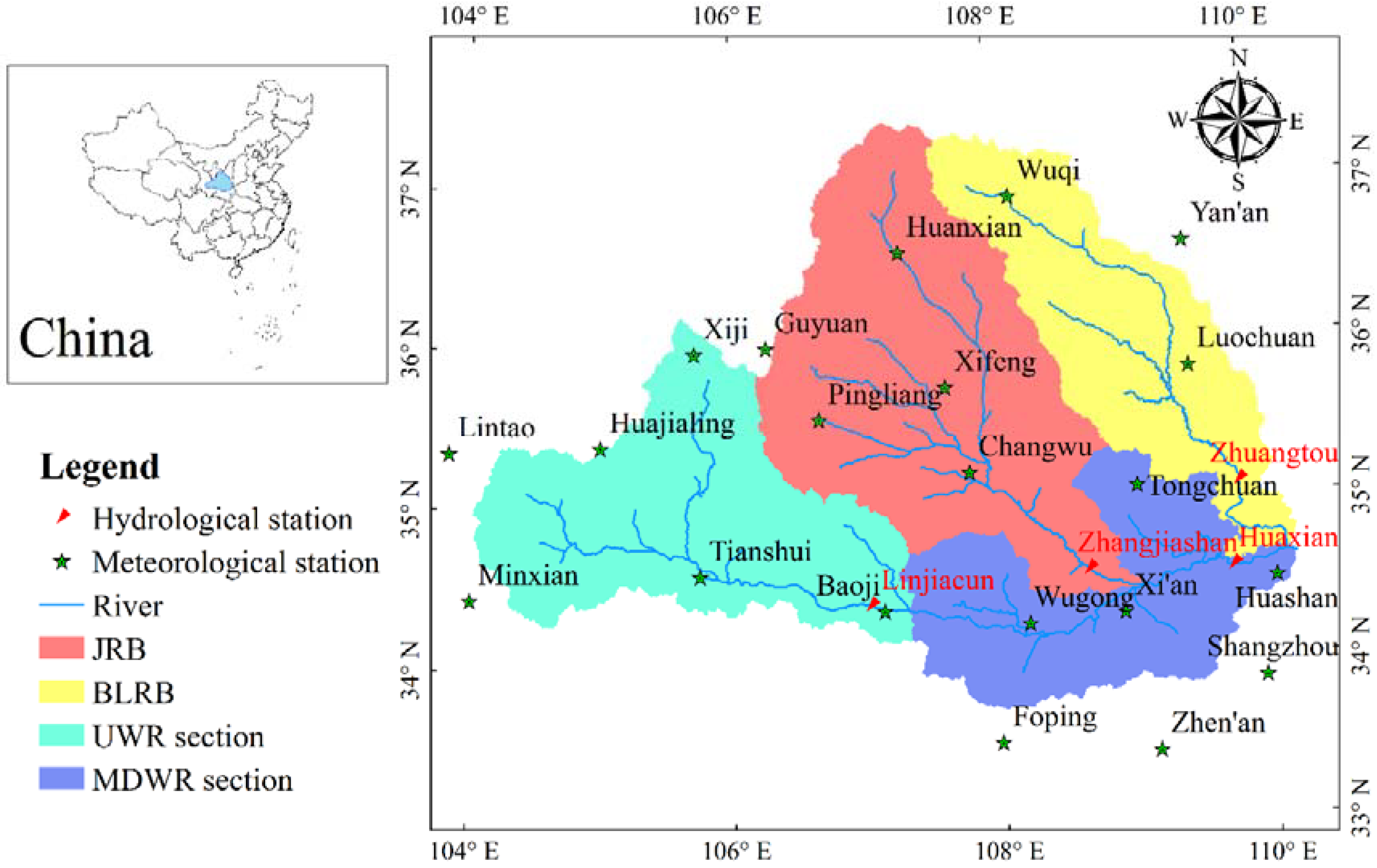
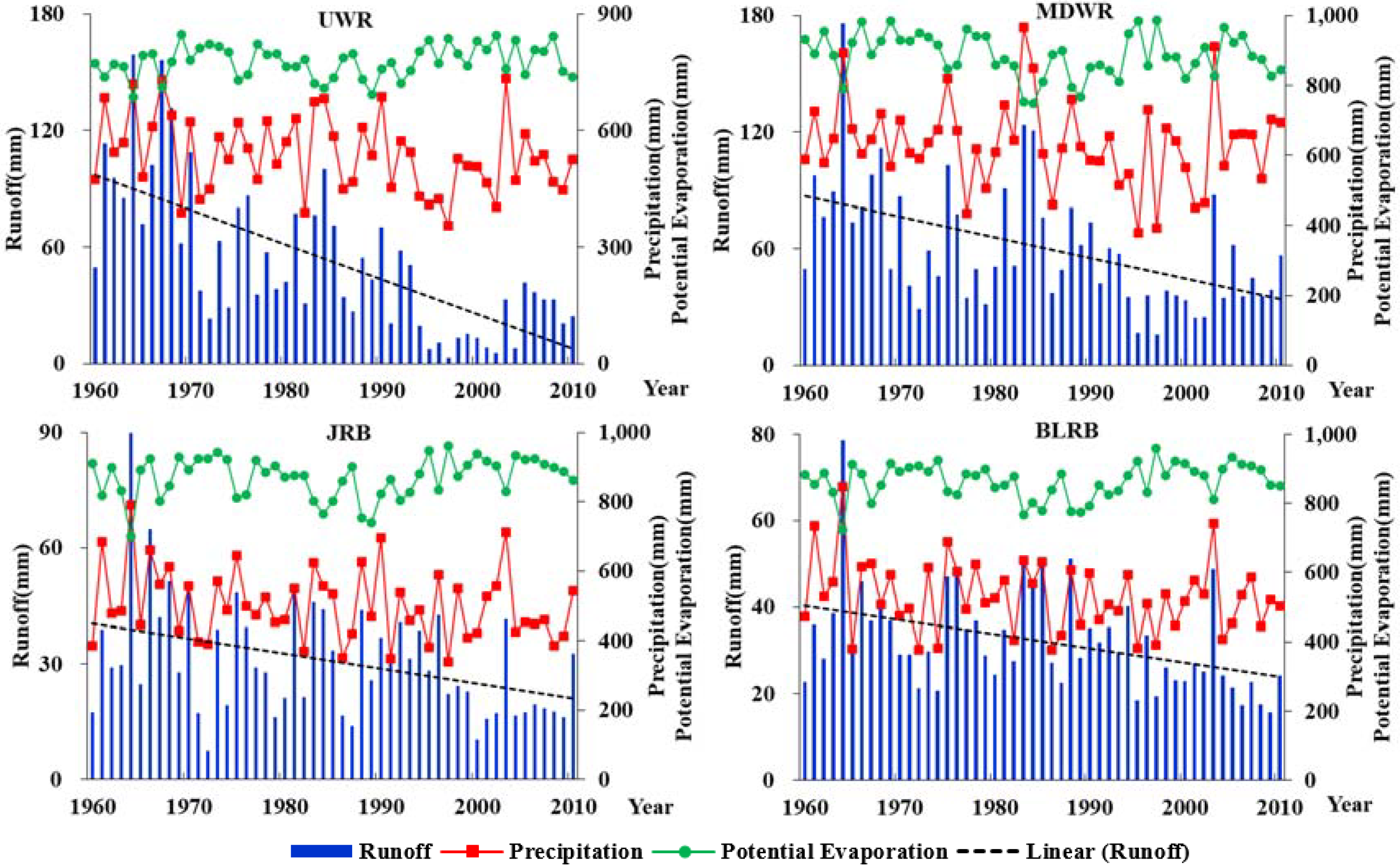
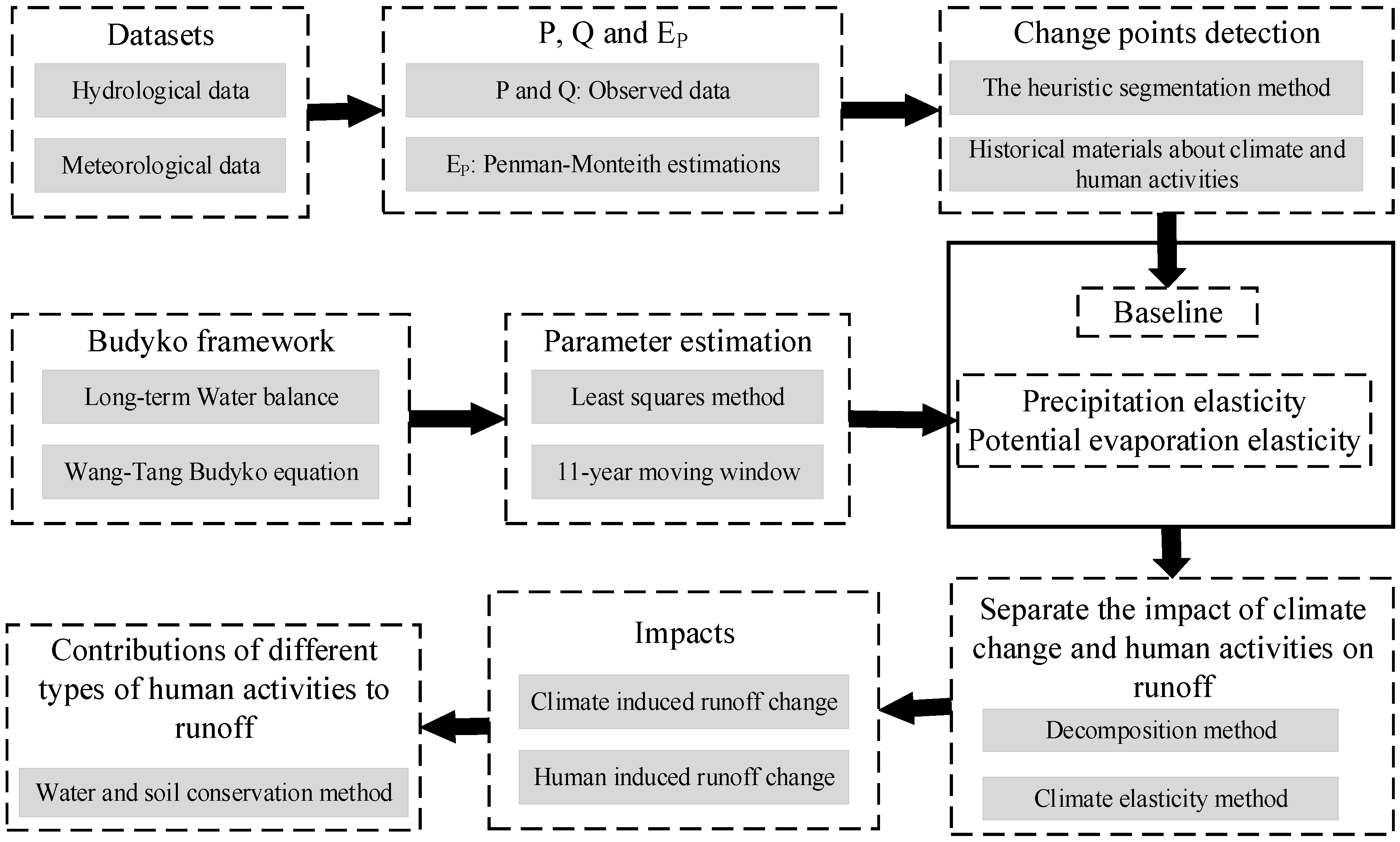
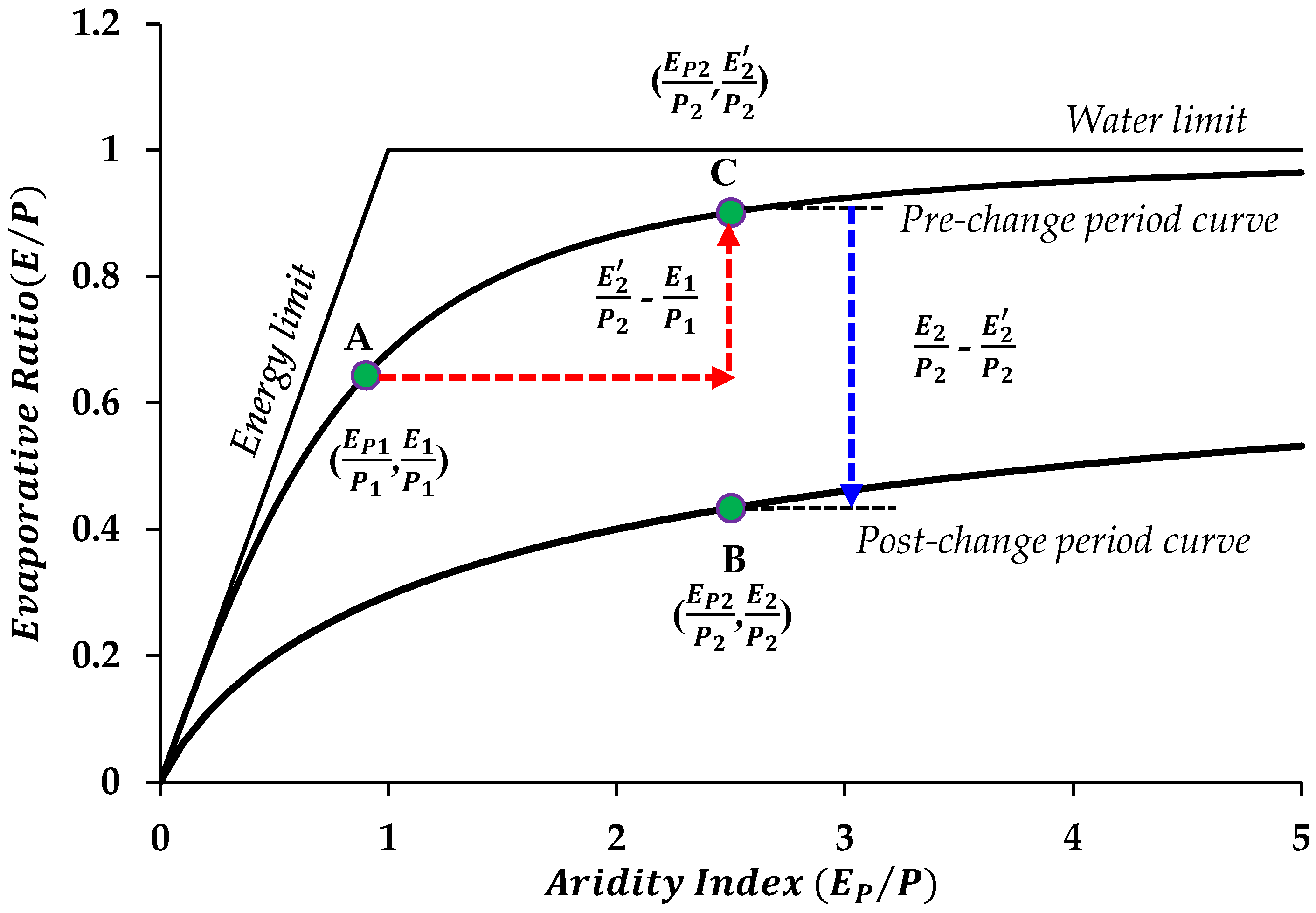
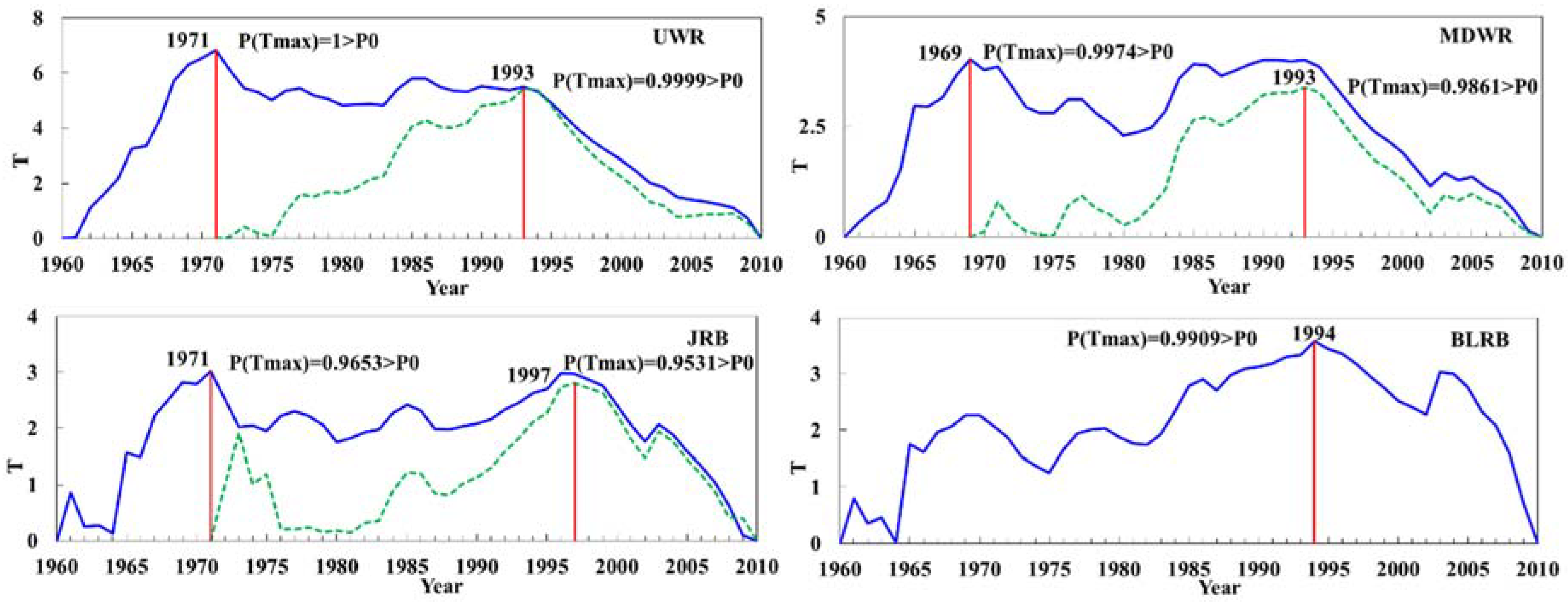
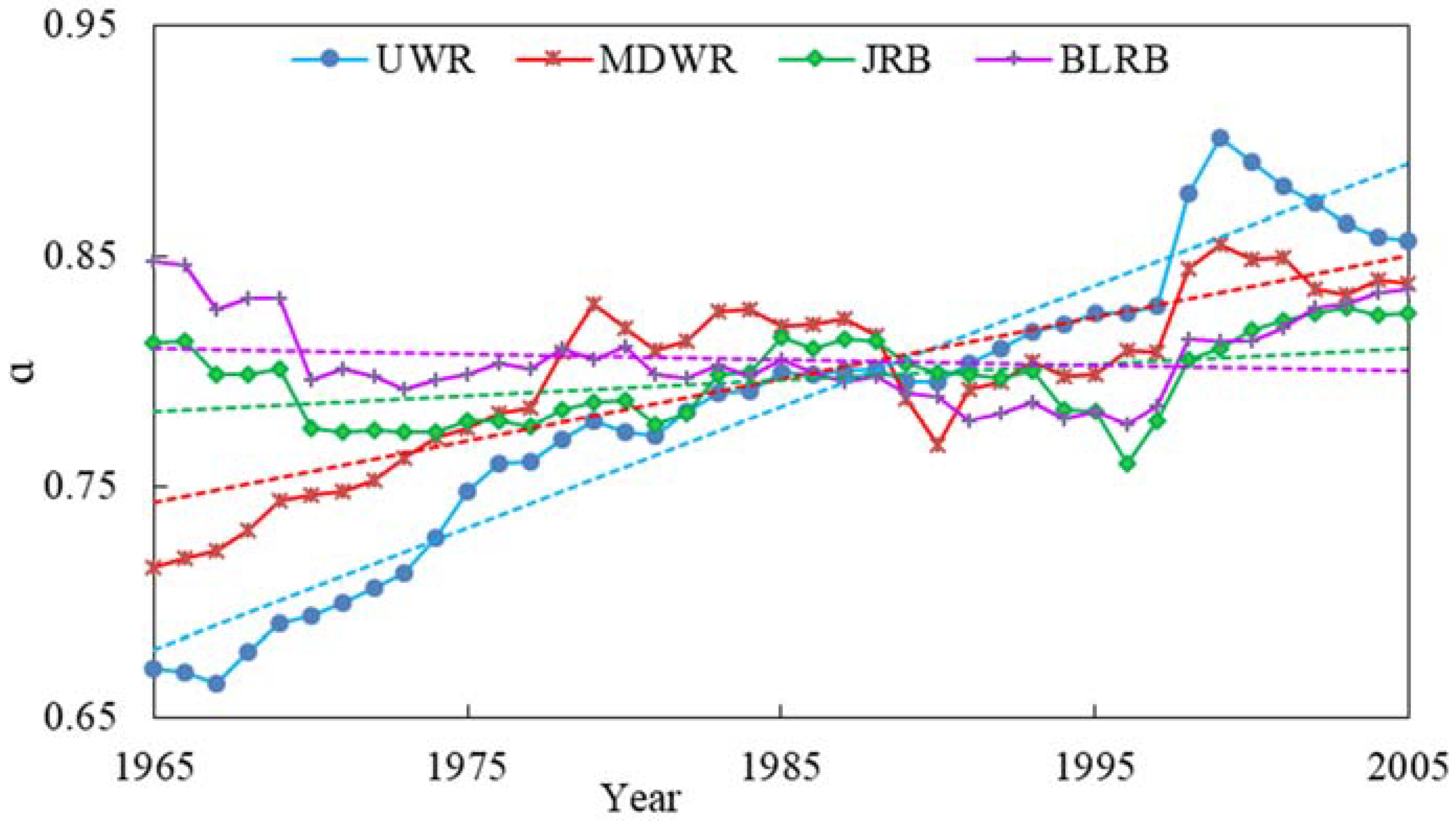
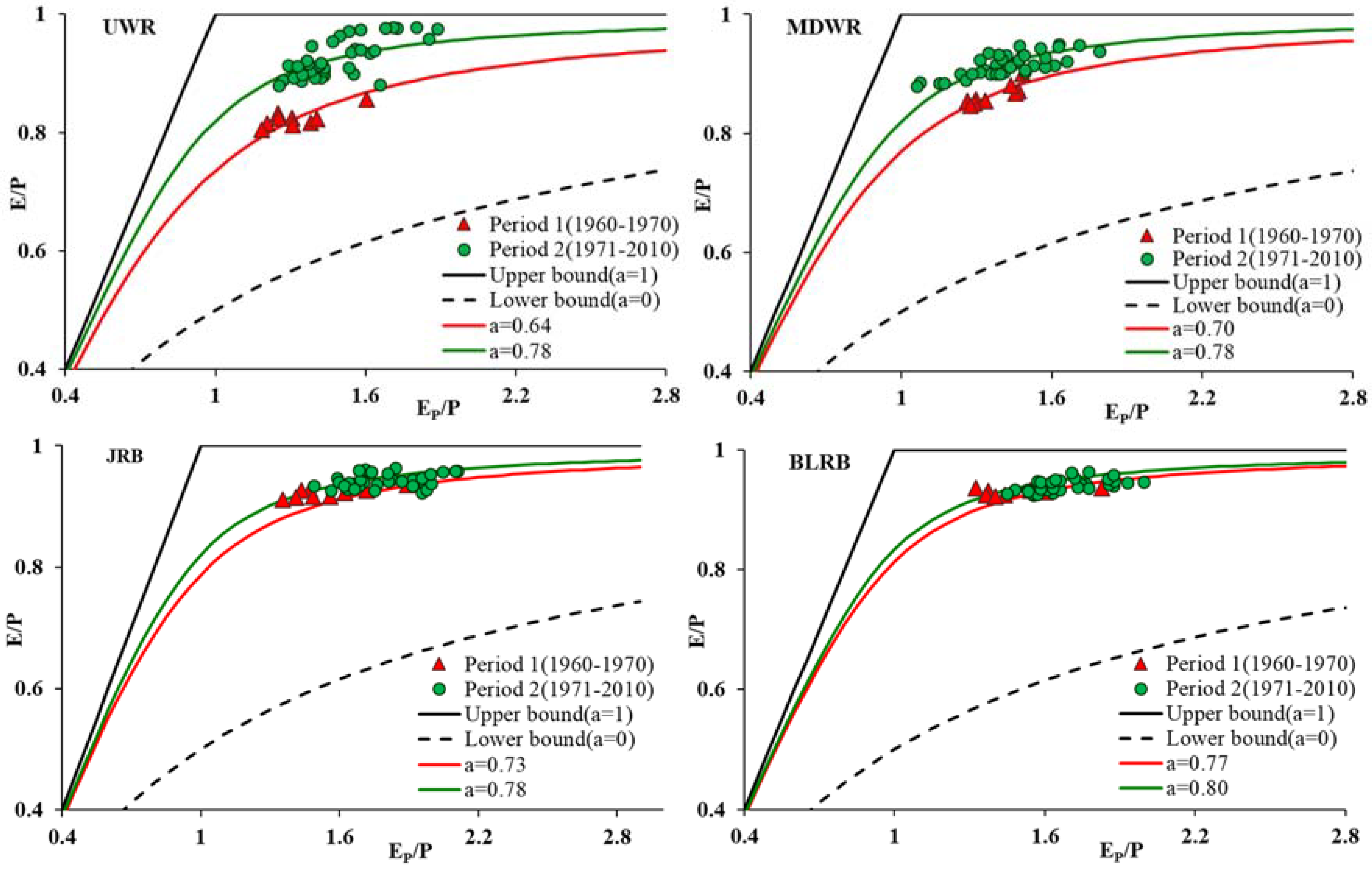
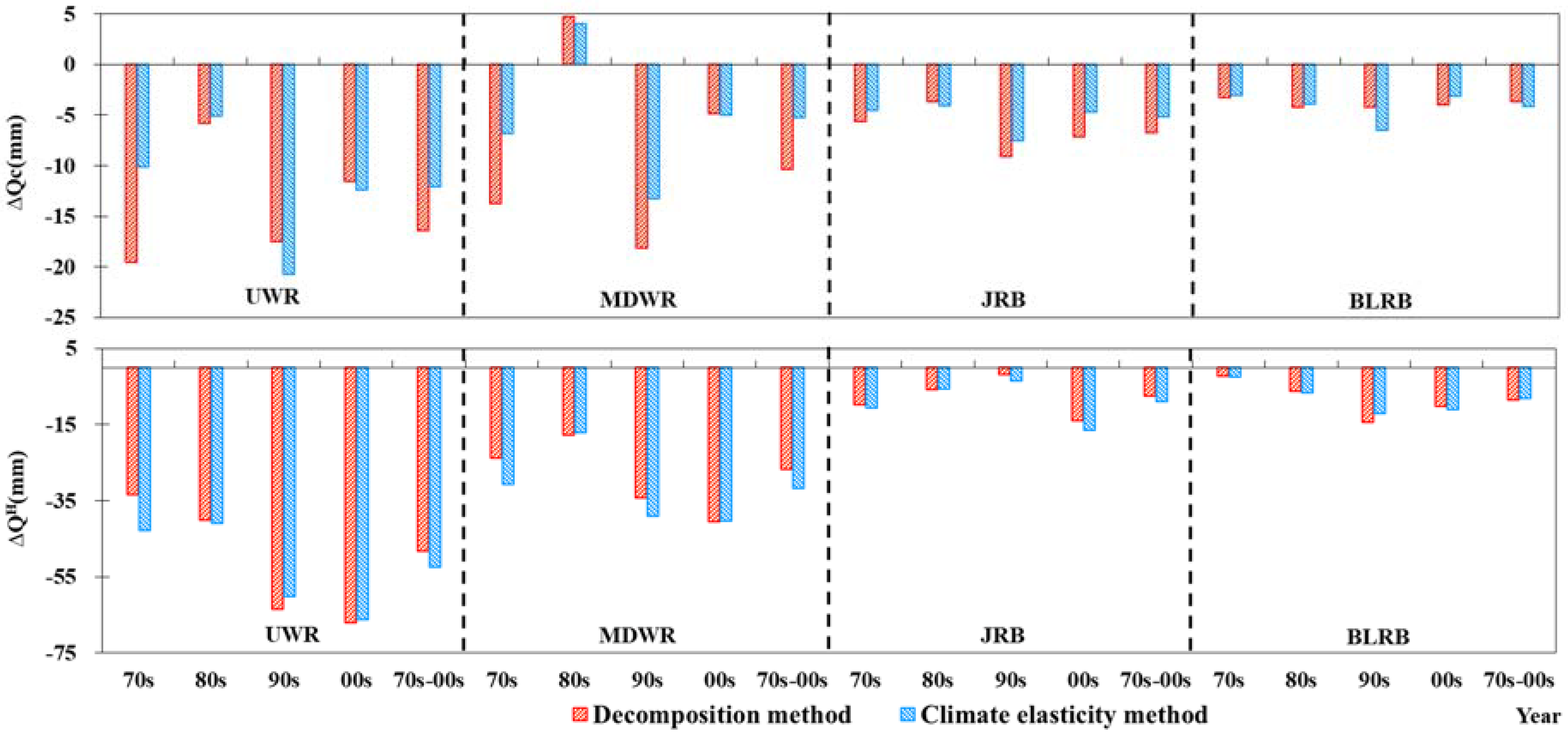
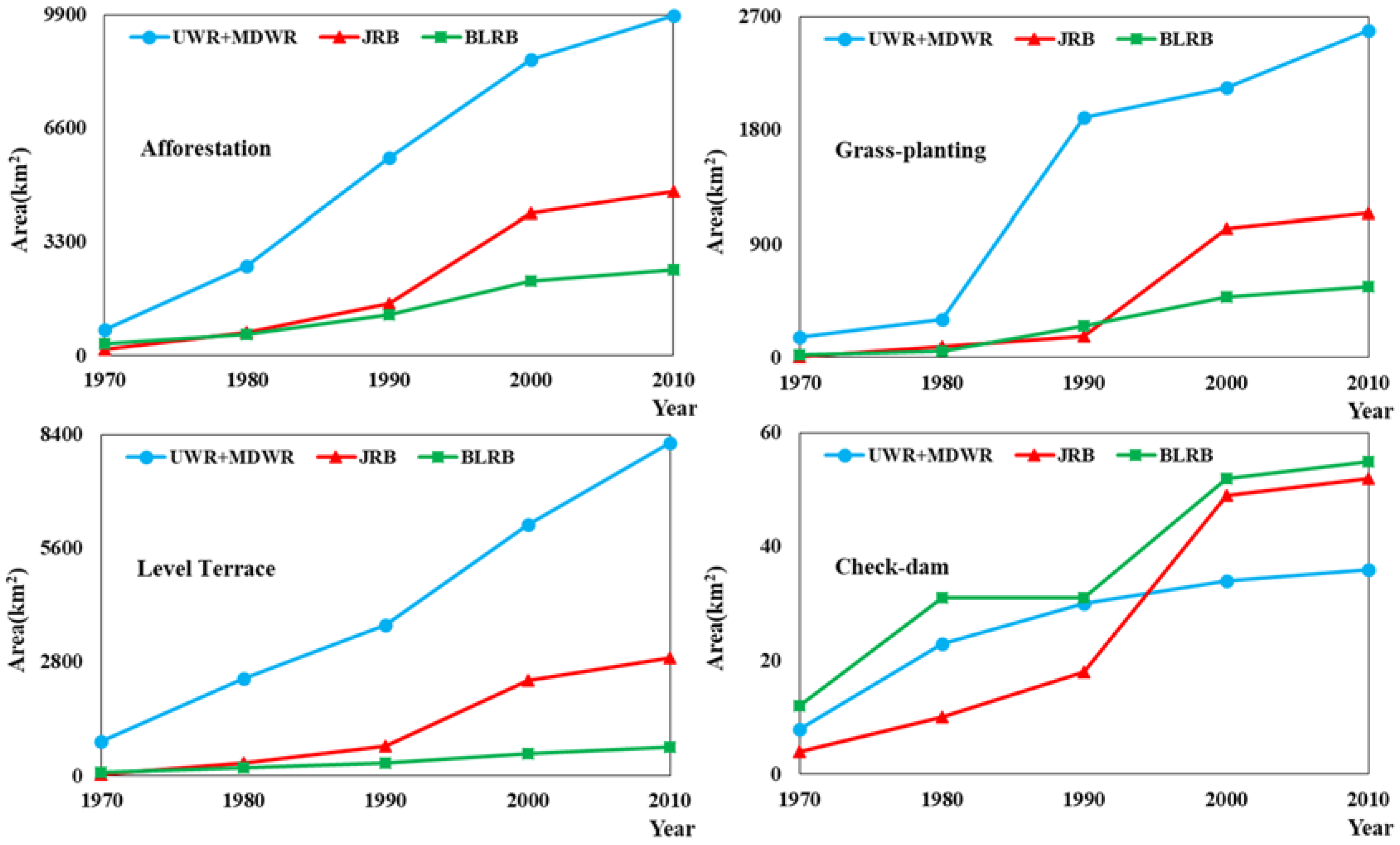
| Gauge Station | Basin | Drainage Area (104 km2) | Period | Average Value | ||||||
|---|---|---|---|---|---|---|---|---|---|---|
| mm/year | 108 km3/year | εP | εEP | |||||||
| Linjiacun | UWR | 3.07 | 1960–2010 | 536.60 | 16.06 | 777.09 | 0.77 | 1.50 | 2.98 | −1.98 |
| Huaxian | MDWR | 10.65 | 1960–2010 | 634.14 | 64.64 | 886.28 | 0.79 | 1.46 | 3.11 | −2.11 |
| Zhangjiashan | JRB | 4.32 | 1960–2010 | 502.48 | 13.30 | 869.93 | 0.80 | 1.81 | 2.93 | −1.93 |
| Zhuangtou | BLRB | 2.56 | 1960–2010 | 530.74 | 8.24 | 863.63 | 0.81 | 1.70 | 3.05 | −2.05 |
| Catchment | No. | Weather Station | Latitude (N) | Longitude (E) | Altitude (m) |
|---|---|---|---|---|---|
| UWR | 1 | Lintao | 35.35 | 103.85 | 1893 |
| 2 | Huajialing | 35.38 | 105.00 | 2450 | |
| 3 | Xiji | 35.97 | 105.72 | 1916 | |
| 4 | Minxian | 34.43 | 104.02 | 2315 | |
| 5 | Tianshui | 34.58 | 105.75 | 1141 | |
| 6 | Baoji | 34.35 | 107.13 | 612 | |
| MDWR | 7 | Wugong | 34.25 | 108.22 | 447 |
| 8 | Xian | 34.30 | 108.93 | 397 | |
| 9 | Tongchuan | 35.08 | 109.07 | 978 | |
| 10 | Foping | 33.52 | 107.98 | 827 | |
| 11 | Zhenan | 33.43 | 109.15 | 693 | |
| 12 | Shangzhou | 33.87 | 109.97 | 742 | |
| 13 | Huashan | 34.48 | 110.08 | 2064 | |
| JRB | 14 | Huanxian | 36.58 | 107.30 | 1255 |
| 15 | Pingliang | 35.55 | 106.67 | 1346 | |
| 16 | Xifeng | 35.73 | 107.63 | 1421 | |
| 17 | Guyuan | 36.00 | 106.27 | 1753 | |
| 18 | Changwu | 35.20 | 107.80 | 1206 | |
| BLRB | 19 | Luochuan | 35.82 | 109.50 | 1159 |
| 20 | Yanan | 36.60 | 109.50 | 958 | |
| 21 | Wuqi | 36.92 | 108.17 | 1331 |
| Regions | Time Period | Average Value (mm/year) | Decomposition Method | Elasticity Method | Average | |||||
|---|---|---|---|---|---|---|---|---|---|---|
| UWR | 1960–1970 | 586.5 | 766.9 | 103.1 | ||||||
| 1971–2010 | 517.7 | 779.2 | 38.44 | 25 | 75 | 19 | 81 | 22 | 78 | |
| MDWR | 1960–1970 | 667.3 | 917.1 | 90.0 | ||||||
| 1971–2010 | 625.0 | 877.8 | 52.9 | 28 | 72 | 14 | 86 | 21 | 79 | |
| JRB | 1960–1970 | 553.2 | 857.9 | 42.4 | ||||||
| 1971–2010 | 488.5 | 873.24 | 28.1 | 47 | 53 | 37 | 64 | 42 | 58 | |
| BLRB | 1960–1970 | 577.4 | 857.7 | 38.6 | ||||||
| 1971–2010 | 517.9 | 865.3 | 26.4 | 30 | 70 | 34 | 66 | 32 | 68 | |
| Average | 1971–2010 | −32.1 | 33 | 67 | 26 | 74 | 29 | 71 | ||
| Catchment | Decade | Level Terrace | Afforestation | Grass-Planting | Check-Dam | Reservoirs | Irrigation | Industrial and Domestic |
|---|---|---|---|---|---|---|---|---|
| UWR + MDWR | 1960s | 4.1 | 1.6 | 0.2 | 0.3 | 93.8 | ||
| 1970s | 4.4 | 2.1 | 0.2 | 0.5 | 92.9 | |||
| 1980s | 6.6 | 4.4 | 1.0 | 0.5 | 87.5 | |||
| 1990s | 9.5 | 5.7 | 0.9 | 0.3 | 83.5 | |||
| 2000s | 12.3 | 6.4 | 1.1 | 0.3 | 79.9 | |||
| Average | 8.1 | 4.5 | 0.8 | 0.4 | 86.2 | |||
| JRB | 1960s | 1.7 | 2.7 | 0.1 | 1.7 | 93.8 | ||
| 1970s | 6.7 | 5.8 | 0.5 | 12.7 | 74.4 | |||
| 1980s | 10.9 | 9.7 | 0.7 | 8.8 | 69.9 | |||
| 1990s | 19.8 | 14.9 | 2.4 | 1.8 | 61.1 | |||
| 2000s | 15.6 | 10.9 | 1.8 | 0.6 | 71.1 | |||
| Average | 14.1 | 10.7 | 1.5 | 3.6 | 70.1 | |||
| BLRB | 1960s | 8.1 | 15.6 | 0.7 | 13.7 | 61.9 | ||
| 1970s | 8.6 | 11.7 | 0.7 | 26.7 | 52.4 | |||
| 1980s | 11.0 | 18.4 | 2.5 | 12.2 | 55.9 | |||
| 1990s | 11.4 | 19.3 | 2.8 | 11.9 | 54.6 | |||
| 2000s | 10.6 | 16.1 | 2.4 | 7.4 | 63.5 | |||
| Average | 10.6 | 16.9 | 2.2 | 11.5 | 58.8 | |||
| WRB | 1960s | 3.5 | 1.9 | 0.2 | 0.8 | 1.6 | 81.1 | 10.9 |
| 1970s | 4.2 | 2.4 | 0.2 | 2.0 | 3.4 | 81.1 | 6.8 | |
| 1980s | 6.2 | 4.6 | 0.9 | 1.4 | 2.1 | 72.9 | 12.0 | |
| 1990s | 7.7 | 5.3 | 0.9 | 0.8 | 1.3 | 55.7 | 28.3 | |
| 2000s | 8.7 | 5.3 | 0.9 | 0.5 | 1.3 | 52.5 | 30.8 | |
| Average | 6.9 | 4.5 | 0.7 | 1.0 | 1.8 | 63.6 | 21.5 |
© 2018 by the authors. Licensee MDPI, Basel, Switzerland. This article is an open access article distributed under the terms and conditions of the Creative Commons Attribution (CC BY) license (http://creativecommons.org/licenses/by/4.0/).
Share and Cite
Zhao, J.; Huang, S.; Huang, Q.; Wang, H.; Leng, G. Detecting the Dominant Cause of Streamflow Decline in the Loess Plateau of China Based onthe Latest Budyko Equation. Water 2018, 10, 1277. https://doi.org/10.3390/w10091277
Zhao J, Huang S, Huang Q, Wang H, Leng G. Detecting the Dominant Cause of Streamflow Decline in the Loess Plateau of China Based onthe Latest Budyko Equation. Water. 2018; 10(9):1277. https://doi.org/10.3390/w10091277
Chicago/Turabian StyleZhao, Jing, Shengzhi Huang, Qiang Huang, Hao Wang, and Guoyong Leng. 2018. "Detecting the Dominant Cause of Streamflow Decline in the Loess Plateau of China Based onthe Latest Budyko Equation" Water 10, no. 9: 1277. https://doi.org/10.3390/w10091277
APA StyleZhao, J., Huang, S., Huang, Q., Wang, H., & Leng, G. (2018). Detecting the Dominant Cause of Streamflow Decline in the Loess Plateau of China Based onthe Latest Budyko Equation. Water, 10(9), 1277. https://doi.org/10.3390/w10091277








